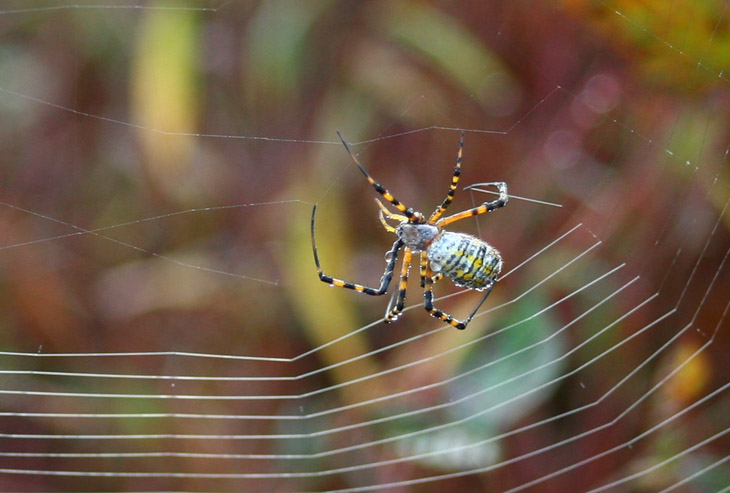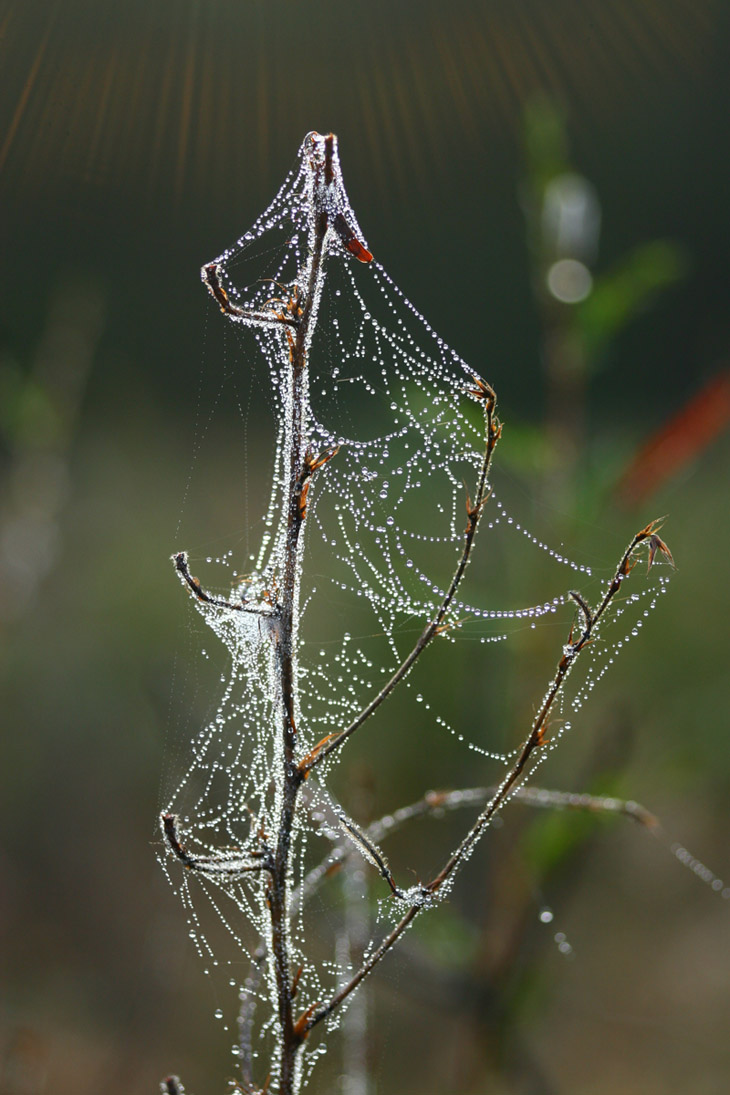
It’s still early in the fall season here and only a handful of trees are showing any color, but if one is selective, they can find examples and frame them to make it seem much more dramatic than, as was the case here, a single small tree in the middle of a still-green landscape. This is a Liquidambar styraciflua, otherwise known by a large number of common names but most often as American sweetgum, one of the few in this area that develop bright colors. The copious morning dew had enhanced this significantly, and featured prominently in just about all other images from this outing as well. “This outing” being last Friday at Mason Farm Biological Reserve where we got out soon after sunrise, “we” being Mr Bugg and I. The remaining photos, as indicated by the post title, are not going to make arachnophobes happy in any way.
But the truth is, dewy mornings are great times to photograph spiderwebs, and even just to drive home how many spiders there really are around us, most of them remaining completely unseen because of their size and subtlety. It’s easiest to see when looking out over a field on a misty morning, but even easy to spot on a well-mowed lawn, as the dew collects on every strand of web in the area and reveals, not just the entrapping webs themselves, but even the draglines left behind by the wandering varieties of spiders; it becomes apparent that very few plants don’t show any signs of arachnid activity.

Now, I’m not even sure this is from a spider – it might be a protective shelter or cocoon of a caterpillar – but it served to capture the dew quite well, and there’s the faintest hint of the lens effect that water droplets will demonstrate; you can see the outline of the horizon inverted in the drops. To make the best of this takes very high magnification, and most importantly, no wind motion at all, which does not describe this day. Not to mention that a close and distinctive subject makes this a whole lot better.
All right, let’s get down to the spiders themselves. We’ll ease into it.

This was a curious find, and as yet I have no explanation for it. There is a subset of spiders known as trashline orbweavers (genus Cyclosa) specifically for the reasons that you see here: not only do they spin the wheel-style “orb” webs, but they arrange the desiccated corpses of their past meals in a line down the center of the web, then sit among them camouflaged from predators. The spider itself is in the middle, right where the bright horizontal bar cuts through, legs tucked in to disguise its true nature – these are very small species. But the key detail is the bright lines of the web itself. This is not dew, and appears to be a different composition than the primary strands, since you can see those in the center, thinner and much more subtle. I have been told that the sticky strands of web are the spiral portions, while the ‘spokes’ are not sticky, allowing spiders to scamper across their webs without ensnaring themselves, and so this would certainly appear to be illustrating the different composition of the webbing. However, I’ve never seen it before, and it seems that being this much more visible, despite the rare backlit conditions, would work against the idea of a web in the first place. But at least it shows the path the spider took a lot better than normal. In a couple of places it also shows the iridescent trait of spider silk that can be captured with just the right conditions and approach – it’s tricky, believe me.

I was hoping to see one of these, though in truth I figured it’d be a slightly different species that’s far more common in the area. This is a banded orbweaver (Argiope trifasciata,) and they’re among the bigger spiders in NC, getting up the 3 cm in body length with the leg spread expanding that to 8 cm. Argiopes love tall plants and spin their large webs at roughly waist-height in the thick of things, often making encounters an abrupt and startling thing (more so if you don’t like spiders.) And while most spiders can show this trait, it becomes very visible on the Argiopes: dew will form on the bodies of the spiders themselves as well as on the webs, and sometimes you find them completely dripping with it. This one was close to that – I’ve seen much worse – but ignoring the burden while industriously re-weaving its web in the early morning light. There’s a possibility that it dismantled and ate the previous web not long before, collecting the moisture while recycling the material, and you will note that the web is showing no signs of dew, being spun after the conditions had passed. In this case, the glow comes strictly from the angle that I was shooting from, since the same strands disappear as they become more vertical, unlike the other example above.
Now let’s get really creepy.

Green lynx spiders (Peucetia viridans) are fairly common around here, though ambush-hunters by nature instead of web-spinners. The primary exception is the cluster of haphazard lines drawing together a collection of leaves which is used as a nursery for the hatched young, and these clusters are easy to spot on such mornings. I couldn’t resist going in for this shot, but I’ll confess it’s actually a stack of three images to bring out varying details, since shooting with a larger aperture at macro magnification meant a very short depth of field; each frame had select details while the rest went soft, so I had to combine them for this family portrait. So yes, that’s mamma in the center and one of the young off to the right, but really, a lot of young off to the right – you can see the legs up there, dozens of little babbies. The mother has completed her primary task, that of reproduction, and isn’t long for this world, living out the rest of her days protecting the young in their earliest stage. She’ll die, and the young may remain in the same shelter throughout the winter or may move on a short distance, but come spring they’ll start actively hunting on their own. Spiders are remarkably cold-resistant, becoming active immediately upon receiving some nice sunlight, even after a snowfall. It’s impressive.
And to close the post, we’ll go a little less creepy, more fartsy. You may recognize the subject from Mr Bugg’s post, and this shows both the limited angles we had to work from that morning, and the subtle differences from two photographers shooting the same subject.

I got quite lucky with mine, I’ll admit it. While shooting directly towards the sun was necessary to bring out the dewdrops in these diamond-like points, it also requires a dark background for best effect, and keeping the sun out of the lens itself is paramount unless you really like glare. In this case, either my hand or my outstretched hat – I don’t recall which – was blocking the sun from the lens just outside of view, but it produced a nice little set of sunburst accents across the top of the frame. I probably couldn’t produce this on demand if I tried, but I’ll happily accept it when it happens.




















































